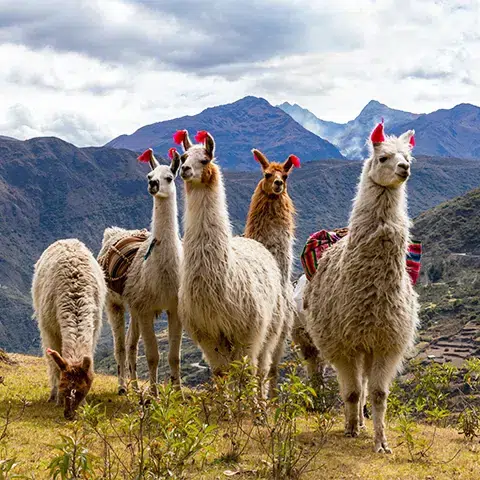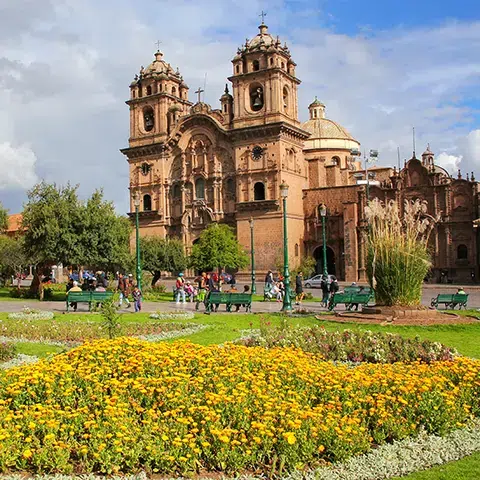Traveling in South America is an experience that every traveler should do once in a lifetime. This continent is a unique place on earth, since it has a vast geographical extension, different climates, and incredible multicultural expressions that reflect its people.
However, traveling by van changes the scenery of the trip: if you use this means of transport to travel through its lands, you will be able to meet more people, incredible places, and above all, be the protagonist of everything that happens in each country.
So if you’re looking to start your adventure with a planned itinerary, Peru tour packages are a great option to explore breathtaking landscapes and rich cultural heritage before continuing your journey through the continent.
South America offers history and adventure, wrapped in archaeological and monumental treasures, providing customs and lifestyles that deserve to be experienced. Join us to discover more about South America and what you need to know to travel it on four wheels.
Why Travel South America by Van
South America is a vast and diverse continent where geography, culture, and climate change rapidly change from one region to another. Traveling by van offers a flexible and immersive way to explore this territory. It allows travelers to access areas that are not easily reachable by public transportation or package tours, and it provides a level of autonomy that few other forms of travel can match.
With a van, you can move at your own pace. This means you’re not restricted to bus routes or hotel check-in times, and you can adjust your plans according to the weather, road conditions, or personal interests. The experience becomes more about the journey than just the destination.
South America is also known for having iconic road routes such as Argentina’s Ruta 40, Chile’s Carretera Austral, and the Pan-American Highway that runs through several countries. These routes are popular among travelers due to their scenic beauty and regional diversity.
While infrastructure varies by country, many areas now support overlanders with a growing number of campgrounds, fuel stations, and local mechanics familiar with camper vans. In short, van travel is increasingly accessible and offers a deep, rewarding experience of South America.
What You Need to Start Your Vanlife Journey
Starting a van journey across South America involves several stages of preparation, both logistical and practical. This section outlines the essentials: choosing a vehicle, preparing legal documents, and equipping the van for different terrains and climates.
1. Choosing a Van
There are three main options: buying, shipping, or renting. Buying locally is common in countries like Chile or Colombia, where foreigners can legally register vehicles. Shipping a van from Europe or North America is another option, though it involves significant cost and paperwork. Renting is ideal for short-term travel and is available in Argentina, Chile, Peru, and Ecuador through local companies.
Each option has trade-offs between flexibility, cost, and time. Ownership gives the most freedom but requires dealing with national vehicle laws and possible resale at the end of the trip. Rental vans are fully equipped but more expensive in the long term and may limit border crossings.
2. Legal Documents and Permits
To drive legally in South America, you’ll need:
- A valid passport (6 months minimum)
- An International Driver’s Permit (IDP) along with your original license
- Vehicle registration and, if applicable, a notarized permission to drive the vehicle
- Temporary Import Permits (TIP) are issued at each border
- Liability insurance (SOAT or equivalent), purchased in each country individually
Border regulations differ, and some countries require additional paperwork. Make physical and digital copies of all essential documents before departure.
3. Vehicle Setup and Gear
A properly equipped van should have the basics for sleeping, cooking, and storage. Essentials include:
- Bed and bedding suited for cold temperatures, especially in the Andes
- Portable stove and kitchen supplies
- Water containers or filtration systems
- Spare tires, basic tools, and mechanical supplies
- Lighting and a power source (solar panels or auxiliary battery)
Depending on your route, you may also need snow chains, mosquito nets, or tire sealant. Fuel availability varies, especially in remote regions like southern Patagonia or parts of Bolivia and Brazil, so planning your refueling points is important.
4. Digital Tools and Offline Support
Reliable navigation tools are critical. Install offline maps (such as Maps.me or Gaia GPS), and use apps like iOverlander for campsite information and local recommendations. Internet access can be limited, so download essential resources in advance.
Before departure, it’s also useful to research local driving laws, fuel types, and road conditions in each country. Being prepared improves safety and reduces delays or complications on the road.
Vehicle Options
There are three primary ways to obtain a van for traveling in South America: renting, buying locally, or shipping your own. Each option depends on the time you have, your budget, and how much flexibility you want.
Renting is ideal for short trips (2 to 12 weeks). It’s hassle-free and available in countries like Chile, Argentina, and Peru. Vans usually come fully equipped, but rental costs add up quickly, and crossing borders may require special permission.
Buying a van locally offers more freedom and is cost-effective for long-term travel (several months or more). Chile is popular among travelers due to its accessible vehicle registration process for foreigners. However, buying and later reselling takes time and patience.
Shipping your van from North America or Europe is an option for experienced overlanders. Most choose to ship to Uruguay or Colombia. It allows you to use a familiar vehicle but involves customs procedures, maritime shipping fees, and planning months ahead.
Documents and Insurance
Traveling across multiple South American countries by van means dealing with various legal and border requirements. While each country differs slightly, most require a standard set of documents.
You’ll need:
- A valid passport (with at least 6 months remaining).
- An international driver’s permit (IDP), in addition to your home license.
- Vehicle registration documents (must match your name, or a notarized authorization).
- A Temporary Import Permit (TIP) is issued at every border crossing.
- SOAT or equivalent vehicle insurance, which must be purchased separately for each country.
Always keep physical and digital copies of these documents. Some countries also require proof of exit (like a plane ticket or onward road plan), especially if your van is on a TIP.
Insurance policies (SOAT) cover third-party liability and are mandatory. Without it, you may be denied entry at the border or face fines during police checks.
Top South America Van Routes by Country
1. Argentina
Ruta Nacional 40 (RN40) is Argentina’s most iconic road trip. Stretching along the Andes from the Bolivian border to Patagonia, it’s one of the longest and most scenic routes in the world.
- Highlights: Quebrada de Humahuaca, Mendoza’s wine region, Bariloche, El Chalten, and Perito Moreno Glacier.
- Roads: Mostly paved, though some remote sections are gravel.
- Why it’s great: Easy to find camping spots, affordable fuel, and friendly locals make Argentina one of the most van-friendly countries on the continent.
2. Chile
Chile offers two radically different van routes: the Carretera Austral in the south, and the Atacama Desert in the north. The Carretera is a legendary road through glaciers, fjords, and forests, while the Atacama is the driest desert on Earth, full of surreal landscapes.
- Highlights: Marble Caves, Coyhaique, Caleta Tortel, San Pedro de Atacama, and Valle de la Luna.
- Roads: Gravel and ferry crossings in the south; paved roads in the north.
- Tips: Stock up on food and fuel before entering remote areas; road conditions can vary dramatically
3. Peru
Peru is compact but geographically intense, with coastlines, high mountains, and the Amazon jungle. Driving your van lets you reach destinations far off the tourist trail.
- Recommended routes: Lima to Arequipa along the coast, or Cusco to the jungle via Quillabamba.
- Highlights: Sacred Valley, Nazca Lines, Colca Canyon, and Cordillera Blanca near Huaraz.
- Conditions: Mountain roads are narrow and steep high-altitude driving experience is a plus.
4. Bolivia
Bolivia is rugged, wild, and rewarding for van travelers who enjoy adventure. It has some of the most dramatic landscapes on the continent, but also some of the most challenging roads.
- Classic routes: From Uyuni to Sucre, and La Paz to Lake Titicaca.
- Highlights: Salar de Uyuni, Laguna Colorada, Eduardo Avaroa Reserve, and the infamous Death Road.
- Conditions: Expect dirt roads, altitude, and long distances between towns. 4×4 recommended for off-road areas.
5. Ecuador
Small in size but big in diversity, Ecuador is perfect for van travel. In a few hours, you can go from volcanic highlands to coastal beaches or the Amazon basin.
- Top route: Avenue of the Volcanoes (Quito to Cuenca).
- Highlights: Cotopaxi National Park, Baños, Quilotoa crater lake, and the coast of Manabí.
- Why it’s ideal: Short distances, good infrastructure, and safe, welcoming communities.
6. Colombia
Colombia’s landscapes are lush and mountainous, and its culture is vibrant and diverse. Overlanding here is becoming increasingly popular thanks to improved roads and growing vanlife networks.
- Popular route: Medellín to the Caribbean coast, via the Coffee Region and Santa Marta.
- Highlights: Tayrona National Park, Zona Cafetera, Tatacoa Desert, and Villa de Leyva.
- Considerations: Road conditions are good, but travel can be slow due to constant elevation changes and winding highways.
7. Brazil
Brazil is enormous, and planning your route is key. Focus on one or two regions to make the most of your time and avoid long, monotonous drives.
- Recommended regions: The southern states (Santa Catarina, Rio Grande do Sul), the coast between Rio and Salvador, or Chapada Diamantina.
- Highlights: Iguazu Falls and Paraty (for experienced drivers only).
- Conditions: Good paved roads in populated areas; remote routes may require 4×4 and navigation tools.
8. Uruguay & Paraguay
Uruguay is calm, accessible, and ideal for a slow life. The Atlantic coast is relaxed and camping-friendly. Paraguay, less traveled, offers rural landscapes and a more off-the-beaten-path experience.
- Uruguay route: Coastal drive from Colonia del Sacramento to Cabo Polonio.
- Paraguay route: Trans-Chaco Highway or the scenic south from Encarnación to Asunción.
- Why go: Uruguay is great for low-key travel and beach stops; Paraguay suits those looking for authenticity and solitude.



0 Comments